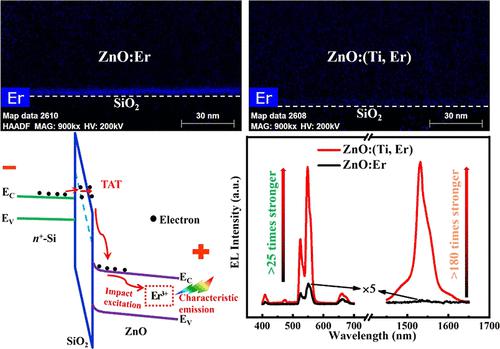当前位置:
X-MOL 学术
›
ACS Appl. Mater. Interfaces
›
论文详情
Our official English website, www.x-mol.net, welcomes your
feedback! (Note: you will need to create a separate account there.)
Electroluminescence from Silicon-Based Light-Emitting Devices with Erbium-Doped ZnO Films: Strong Enhancement Effect of Titanium Codoping
ACS Applied Materials & Interfaces ( IF 8.3 ) Pub Date : 2022-09-21 , DOI: 10.1021/acsami.2c08003 Chengtao Xia 1 , Jinxin Chen 1 , Tong Zhao 1 , Linlin Fan 1 , Deren Yang 1 , Xiangyang Ma 1
ACS Applied Materials & Interfaces ( IF 8.3 ) Pub Date : 2022-09-21 , DOI: 10.1021/acsami.2c08003 Chengtao Xia 1 , Jinxin Chen 1 , Tong Zhao 1 , Linlin Fan 1 , Deren Yang 1 , Xiangyang Ma 1
Affiliation

|
We report on the visible and near-infrared electroluminescence (EL) from the light-emitting device (LED) based on the erbium (Er)-doped ZnO (ZnO:Er)/SiO2/n+-Si heterostructure, wherein an ∼10 nm thick SiO2 intermediate layer serves as the energy plateau for producing hot electrons, which come from n+-Si via the trap-assisted tunneling mechanism. These hot electrons excite the doped Er3+ ions by inelastic collision, enabling the Er-related EL from the aforementioned LED. More importantly, by means of codoping the appropriate content of titanium (Ti) into the ZnO:Er film, the aforementioned Er-related emissions can be significantly enhanced. The density functional theory calculations indicate that the Ti-codoping improves rather than degrades the symmetry of the crystal field around the optically active Er3+ ions, hence not increasing the intra-4f transition probabilities of Er3+ ions. However, it is found that Ti-codoping nearly eliminates the segregation of Er3+ ions near the ZnO/SiO2 interface. Moreover, Ti-codoping is derived to result in a number of Zn vacancies, which provide the sites for incorporating Er3+ ions in the ZnO matrix. For the above two reasons, the Ti-codoping promotes the incorporation of optically active Er3+ ions into the ZnO matrix, thus enhancing the EL from the aforementioned LED.
中文翻译:

掺铒 ZnO 薄膜的硅基发光器件的电致发光:钛共掺杂的强增强效应
我们报告了基于铒(Er)掺杂的ZnO(ZnO:Er)/SiO 2 /n + -Si异质结构的发光器件(LED)的可见光和近红外电致发光(EL),其中~ 10 nm 厚的 SiO 2中间层用作产生热电子的能量平台,热电子来自 n + -Si 通过陷阱辅助隧穿机制。这些热电子激发掺杂的 Er 3+离子通过非弹性碰撞,使上述 LED 的 Er 相关 EL 成为可能。更重要的是,通过将适当含量的钛 (Ti) 共掺杂到 ZnO:Er 薄膜中,可以显着增强上述与 Er 相关的发射。密度泛函理论计算表明,Ti共掺杂改善而不是降低光学活性Er 3+离子周围晶体场的对称性,因此不会增加Er 3+ 离子的4f内跃迁概率。然而,发现Ti共掺杂几乎消除了在ZnO/SiO 2界面附近的Er 3+离子的偏析。此外,Ti 共掺杂导致许多 Zn 空位,这为掺入 Er 提供了位点ZnO 基质中的3+离子。由于上述两个原因,Ti共掺杂促进了光学活性Er 3+离子结合到ZnO基体中,从而增强了上述LED的EL。
更新日期:2022-09-21
中文翻译:

掺铒 ZnO 薄膜的硅基发光器件的电致发光:钛共掺杂的强增强效应
我们报告了基于铒(Er)掺杂的ZnO(ZnO:Er)/SiO 2 /n + -Si异质结构的发光器件(LED)的可见光和近红外电致发光(EL),其中~ 10 nm 厚的 SiO 2中间层用作产生热电子的能量平台,热电子来自 n + -Si 通过陷阱辅助隧穿机制。这些热电子激发掺杂的 Er 3+离子通过非弹性碰撞,使上述 LED 的 Er 相关 EL 成为可能。更重要的是,通过将适当含量的钛 (Ti) 共掺杂到 ZnO:Er 薄膜中,可以显着增强上述与 Er 相关的发射。密度泛函理论计算表明,Ti共掺杂改善而不是降低光学活性Er 3+离子周围晶体场的对称性,因此不会增加Er 3+ 离子的4f内跃迁概率。然而,发现Ti共掺杂几乎消除了在ZnO/SiO 2界面附近的Er 3+离子的偏析。此外,Ti 共掺杂导致许多 Zn 空位,这为掺入 Er 提供了位点ZnO 基质中的3+离子。由于上述两个原因,Ti共掺杂促进了光学活性Er 3+离子结合到ZnO基体中,从而增强了上述LED的EL。













































 京公网安备 11010802027423号
京公网安备 11010802027423号